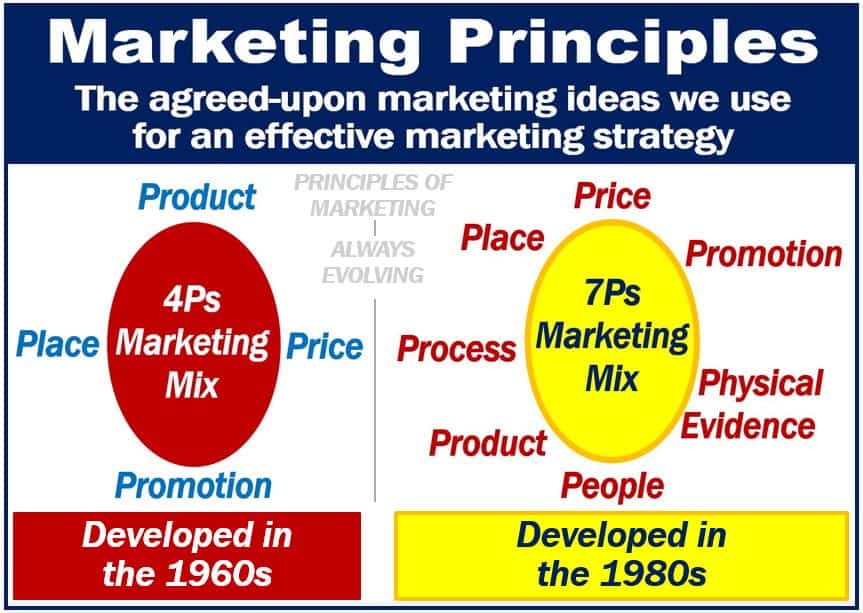A marketing mix is a planned mix of elements that make up the marketing plan of a product or service. There are typically four elements: Product, Price, Place, and Promotion. They all start with the letter ‘P.’ Hence, we can say the marketing mix or the 4Ps. Some people also call the mix the 4Ps Strategy or the 4Ps Marketing Matrix.
It should be noted that sometimes ‘Presentation’ substitutes ‘Product’ in the first ‘P.’
Companies adjust the 4Ps until they find the combination that is just right for the product. In other words, the marketing mix that generates the most profit and also satisfies customers’ needs, wants, and expectations.
Some marketing executives refer to the marketing mix of the 4Ps as the marketing principles. We use the marketing principles for the successful promotion of either goods or services.
Philip Kotler, an American marketing author, consultant, and professor, once said:
“The marketing mix is the set of marketing tools that the firm uses to pursue its marketing objectives in the target market.”
Prof. Kotler is the S. C. Johnson Distinguished Professor of International Marketing at the Kellogg School of Management at Northwestern University.
Marketing tools are tools that businesses use to promote their products and services. They also use them to determine what new products to develop and how to improve their existing ones.

Marketing and the marketing mix
Marketing is a management process through which goods and services move from concept to the final consumer, i.e., the end user. It includes the identification of a good or service, determining demand, deciding on a price, and choosing distribution channels.
It also includes the development and implementation of a promotional strategy. As a business strategy, marketing has been around for thousands of years.
Marketing theory, on the other hand, emerged at the beginning of the last century. The contemporary marketing mix of the 4Ps emerged in the 1960s. It has become a dominant framework for marketing management decisions (see the end of this article for the 7Ps).
4 elements of the marketing mix
Below is an explanation of the four elements of the marketing mix – they all start with the letter ‘P’:
Product
This term refers to an item that satisfies the needs or wants of the consumer. The word products, in this context, also includes services.
It, therefore, includes tangible items, i.e., goods, and intangible items, i.e., services, experiences, or ideas. If something is tangible, you can touch it, i.e., it is a physical item. The word intangible refers to something we cannot touch; it is abstract (not physical).
Typical product marketing decisions include branding, product range/mix, product lines, and packaging and labeling. It also includes guarantees, warranties, returns, and managing products through the life-cycle.
Price
This term refers to how much buyers pay for the product. It may also refer to the sacrifice customers are prepared to make to purchase a product. Sacrifice includes, for example, time and effort.
This element of the marketing mix is the only one that has implications for revenue and profit margins. It also includes considerations of customers’ perceived value.
Typical marketing decisions include price strategy, price tactics, and price setting. They also include discounts for customers and payment terms.
Place
Place is all about where the manufacturer makes and sells the product. In other words, the products’ place of origin and the provision of customer access.
Location can affect customer service as well as how rapidly the seller can respond to orders and requests.
Typical marketing decisions include where best to sell the product and where consumers are likely to look for it. They also include how to get the product to where consumers are.
Is it a B2B, B2C, or B2G business?
- B2B stands for business-to-business – in other words, the company’s customers are other companies.
- B2C stands for business-to-customer, i.e., the company sells to individual consumers (retail).
- B2G stands for business-to-government. Defense contractors, for example, are B2G – their customer is the government (mainly).
Promotion
This element of the marketing mix is all about telling consumers about the product. In other words, marketing communications. Promotion may consist of public relations (PR), direct marketing, advertising, and sales promotion.
Marketing decisions include determining what promotion mix is best as well as the message strategy. They also include determining channel/media strategies and message frequency.
If the product is seasonal, for example, getting the timing of the promotional activities right is crucial.
Marketing mix – 7Ps
There is another marketing mix that has seven elements. We call them the 7Ps because they all start with the letter ‘P.’ The seven Ps are Product, Place, Price, Promotion, People, Physical Environment, and Process.
Regarding the 7Ps marketing mix, Professional Academy says:
“Though in place since the 1980’s, the 7Ps are still widely taught due to their fundamental logic being sound in the marketing environment and marketers abilities to adapt the marketing mix to include changes in communications.”
Social media, for example, is one of the changes in communication.
Compound phrases with ‘Marketing Mix’
The term ‘Marketing Mix’ is a 2-word compound phrase. From this term we can make many 3-word compound phrases. Let’s have a look at 5 of them:
- Marketing Mix Analysis – Reviewing the strategies in the marketing mix.
- Marketing Mix Modeling – Using statistics to forecast marketing outcomes.
- Marketing Mix Optimization – Adjusting the marketing mix for best results.
- Marketing Mix Strategy – Integrating the four Ps for marketing goals.
- Marketing Mix Adaptation – Tailoring the marketing mix for different markets.
